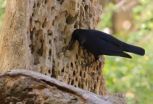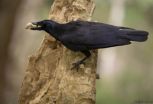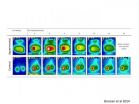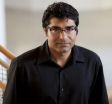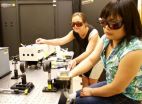(Press-News.org) In Aesop's fable about the crow and the pitcher, a thirsty bird happens upon a vessel of water, but when he tries to drink from it, he finds the water level out of his reach. Not strong enough to knock over the pitcher, the bird drops pebbles into it — one at a time — until the water level rises enough for him to drink his fill.
Highlighting the value of ingenuity, the fable demonstrates that cognitive ability can often be more effective than brute force. It also characterizes crows as pretty resourceful problem solvers. New research conducted by UC Santa Barbara's Corina Logan, with her collaborators at the University of Auckland in New Zealand, proves the birds' intellectual prowess may be more fact than fiction. Her findings, supported by the National Geographic Society/Waitt Grants Program, appear today in the scientific journal PLOS ONE.
Logan is lead author of the paper, which examines causal cognition using a water displacement paradigm. "We showed that crows can discriminate between different volumes of water and that they can pass a modified test that so far only 7- to 10-year-old children have been able to complete successfully. We provide the strongest evidence so far that the birds attend to cause-and-effect relationships by choosing options that displace more water."
Logan, a junior research fellow at UCSB's SAGE Center for the Study of the Mind, worked with New Caledonian crows in a set of small aviaries in New Caledonia run by the University of Auckland. "We caught the crows in the wild and brought them into the aviaries, where they habituated in about five days," she said. Keeping families together, they housed the birds in separate areas of the aviaries for three to five months before releasing them back to the wild.
Getting individual crows into the testing room proved to be an immediate challenge. "You open the testing room door and then open the aviary door, with the idea that the bird you want is going to fly through into the testing room," she said. But with four birds in an aviary, directing a particular test subject is tricky at best.
"So I thought, let's pretend the sky's the limit and I can train them to do whatever I want," Logan said. "I started by pointing at the one I wanted and continuing to point until he or she flew out. I got to the point where I could stand outside the aviary and point at the one I wanted and it would fly out while the other birds stayed put."
Two birds in particular — 007 and Kitty — became so well trained that Logan had only to call them by name and they'd fly into the testing room.
The testing room contained an apparatus consisting of two beakers of water, the same height, but one wide and the other narrow. The diameters of the lids were adjusted to be the same on each beaker. "The question is, can they distinguish between water volumes?" Logan said. "Do they understand that dropping a stone into a narrow tube will raise the water level more?" In a previous experiment by Sarah Jelbert and colleagues at the University of Auckland, the birds had not preferred the narrow tube. However, in that study, the crows were given 12 stones to drop in one or the other of the beakers, giving them enough to be successful with either one.
"When we gave them only four objects, they could succeed only in one tube — the narrower one, because the water level would never get high enough in the wider tube; they were dropping all or most of the objects into the functional tube and getting the food reward," Logan explained. "It wasn't just that they preferred this tube, they appeared to know it was more functional."
However, she noted, we still don't know exactly how the crows think when solving this task. They may be imagining the effect of each stone drop before they do it, or they may be using some other cognitive mechanism. "More work is needed," Logan said.
Logan also examined how the crows react to the U-tube task. Here, the crows had to choose between two sets of tubes. With one set, when subjects dropped a stone into a wide tube, the water level raised in an adjacent narrow tube that contained food. This was due to a hidden connection between the two tubes that allowed water to flow. The other set of tubes had no connection, so dropping a stone in the wide tube did not cause the water level to rise in its adjacent narrow tube.
Each set of tubes was marked with a distinct color cue, and test subjects had to notice that dropping a stone into a tube marked with one color resulted in the rise of the floating food in its adjacent small tube. "They have to put the stones into the blue tube or the red one, so all you have to do is learn a really simple rule that red equals food, even if that doesn't make sense because the causal mechanism is hidden," said Logan.
As it turns out, this is a very challenging task for both corvids (a family of birds that includes crows, ravens, jays and rooks) and children. Children ages 7 to 10 were able to learn the rules, as Lucy Cheke and colleagues at the University of Cambridge discovered in 2012. It may have taken a couple of tries to figure out how it worked, Logan noted, but the children consistently put the stones into the correct tube and got the reward (in this case, a token they exchanged for stickers). Children ages 4 to 6, however, were unable to work out the process. "They put the stones randomly into either tube and weren't getting the token consistently," she said.
Recently, Jelbert and colleagues from the University of Auckland put the New Caledonian crows to the test using the same apparatus the children did. The crows failed. So Logan and her team modified the apparatus, expanding the distance between the beakers. And Kitty, a six-month-old juvenile, figured it out. "We don't know how she passed it or what she understands about the task," Logan said, "so we don't know if the same cognitive processes or decisions are happening as with the children, but we now have evidence that they can. It's possible for the birds to pass it.
"What we do know is that one crow behaved like the older children, which allows us to explore how they solve this task in future experiments," she continued. Research on causal cognition using the water displacement paradigm is only beginning to get at what these crows know about solving problems. This series of experiments shows that modifying previous experiments is useful for gaining a deeper understanding.
The research on the crows is part of a larger project Logan is working on to compare the cognitive powers of crows with those of grackles. "So far, no smaller-brained species have been tested with the tests we use on the crows, and grackles are smaller-brained," she said. "But they're really innovative. So they may have a reason to pay attention to causal information like this."
The next research phase will begin next month, after the grackles' breeding season ends and they are ready to participate.
INFORMATION: END
Smarter than a first-grader?
UCSB researcher shows that New Caledonian crows can perform as well as 7- to 10-year-olds on cause-and-effect water displacement tasks
2014-07-23
ELSE PRESS RELEASES FROM THIS DATE:
How honey bees stay cool
2014-07-23
MEDFORD/SOMERVILLE, Mass. – Honey bees, especially the young, are highly sensitive to temperature and to protect developing bees, adults work together to maintain temperatures within a narrow range. Recently published research led by Philip T. Starks, a biologist at Tufts University's School of Arts and Sciences, is the first to show that worker bees dissipate excess heat within a hive in process similar to how humans and other mammals cool themselves through their blood vessels and skin.
"This study shows how workers effectively dissipate the heat absorbed via heat-shielding, ...
Hormones after breast cancer: Not fuel for the fire after all?
2014-07-23
A new study supports a growing body of research suggesting a safe and effective role for natural steroid hormones in treating postmenopausal breast cancer, with fewer detrimental side effects and improved health profile than with standard anti-hormone therapies. The study will be published in final format today in the open-access journal Reproductive Biology and Endocrinology.
Breast cancer is the most frequently diagnosed cancer in women in the United States. Approximately 70% of breast cancers are diagnosed in postmenopausal women. Major clinical trials and experimental ...
'Big picture' thinking doesn't always lead people to indulge less, study says
2014-07-23
CHAMPAIGN, Ill. — Buy the latest electronic gizmo du jour, or use that money to fix a leaky roof? Go out with friends, or stay home to catch-up on work to meet that looming deadline? And after you've finished that big project, do you treat yourself to a slice of chocolate cake or settle for a piece of fruit?
These are the kind of self-control dilemmas that people face all the time. And according to research from a University of Illinois expert in new product development and marketing, self-focus plays an important role in how consumers make decisions.
When prompted ...
Urban heat boosts some pest populations 200-fold, killing red maples
2014-07-23
New research from North Carolina State University shows that urban "heat islands" are slowly killing red maples in the southeastern United States. One factor is that researchers have found warmer temperatures increase the number of young produced by the gloomy scale insect – a significant tree pest – by 300 percent, which in turn leads to 200 times more adult gloomy scales on urban trees.
"We'd been seeing higher numbers of plant-eating insects like the gloomy scale in cities, and now we know why," says Adam Dale, a Ph.D. student at NC State and lead author of two papers ...
NASA sees Typhoon Matmo making second landfall in China
2014-07-23
NASA's Terra satellite passed over Typhoon Matmo when it was moving through the Taiwan Strait for its final landfall in mainland China.
On July 23 at 02:45 UTC (July 22 at 10:45 p.m. EDT), the Moderate Resolution Imaging Spectroradiometer or MODIS instrument aboard NASA's Terra satellite captured a picture of Typhoon Matmo after its center crossed the northern part of the island nation of Taiwan and entered the Taiwan Strait. The Taiwan Strait is the body of water between western Taiwan and southeastern China. The MODIS image showed a cloud-covered center of circulation, ...
Targeting the brain to treat obesity
2014-07-23
Unlocking the secrets to better treating the pernicious disorders of obesity and dementia reside in the brain, according to a paper from American University's Center for Behavioral Neuroscience. In the paper, researchers make the case for treating obesity with therapies aimed at areas of the brain responsible for memory and learning. Furthermore, treatments that focus on the hippocampus could play a role in reducing certain dementias.
"In the struggle to treat these diseases, therapies and preventive measures often fall short. This is a new way for providers who treat ...
UNC researchers find unsuspected characteristics of new CF drugs, offering potential paths to more effective therapies
2014-07-23
In lab experiments using tissue samples cultured from cystic fibrosis patients, scientists at the UNC School of Medicine and the UNC Marsico Lung Institute have shown that a new CF drug counteracts the intended beneficial molecular effect of another CF drug.
The finding, published today in the journal Science Translational Medicine, shows how a mutant CFTR protein becomes unstable and loses its ability to function properly when in the presence of the two drugs. The research offers several insights into how novel CF pharmacotherapies could be improved.
“In our human ...
Spinach could lead to alternative energy more powerful than Popeye
2014-07-23
WEST LAFAYETTE, Ind. — Spinach gave Popeye super strength, but it also holds the promise of a different power for a group of scientists: the ability to convert sunlight into a clean, efficient alternative fuel.
Purdue University physicists are part of an international group using spinach to study the proteins involved in photosynthesis, the process by which plants convert the sun's energy into carbohydrates used to power cellular processes.
"The proteins we study are part of the most efficient system ever built, capable of converting the energy from the sun into chemical ...
The birth of topological spintronics
2014-07-23
The discovery of a new material combination that could lead to a more efficient approach to computer memory and logic will be described in the journal Nature on July 24, 2014. The research, led by Penn State University and Cornell University physicists, studies "spin torque" in devices that combine a standard magnetic material with a novel material known as a "topological insulator." The team's results show that such a scheme can be 10 times more efficient for controlling magnetic memory or logic than any other combination of materials measured to date.
"This is a really ...
Strategy proposed for preventing diseases of aging
2014-07-23
AUDIO:
Some researchers are proposing that changing how medical care is delivered could help prevent multiple chronic diseases and extend healthy lifespan. The idea, they argue, would be to target the...
Click here for more information.
Medicine focuses almost entirely on fighting chronic diseases in a piecemeal fashion as symptoms develop. Instead, more efforts should be directed to promoting interventions that have the potential to prevent multiple chronic diseases and extend ...
LAST 30 PRESS RELEASES:
EuBiologics’ simplified OCV achieves WHO PQ
GPT-4 matches radiologists in detecting errors in radiology reports
SwRI to discuss automotive decarbonization, automation at SAE International’s WCX™ 2024
From a cryptic genetic element in the human gut to a sensitive biomarker
Researchers can help shipowners achieve ambitious climate targets
Florida Wildlife Corridor eases worst impacts of climate change
Creating an island paradise in a fusion reactor
Field-margin wetlands alone can’t fix the Gulf of Mexico’s dead zone
Research has lost none of its innovative drive
A nematode gel to protect crops in Africa and Asia
Breakthrough in benzofuran synthesis: New method enables complex molecule creation
Exploring the interactions between baby marmosets and their caregivers
MD Anderson and CureVac enter strategic collaboration to develop novel cancer vaccines
Deadly bacteria show thirst for human blood
New insights could unlock immunotherapy for rare, deadly eye cancer
Biodiversity is key to the mental health benefits of nature, new study finds
A single atom layer of gold – LiU researchers create goldene
Most countries struggle to meet climate pledges from 2009
Photonic computation with sound waves
New study focuses on the placenta for clues to the development of gestational diabetes
Care home staff and residents need ‘family’ bonds to thrive
New Inflammatory Bowel Disease testing protocol could speed up diagnosis
Most massive stellar black hole in our galaxy found
New review offers first recommendations on accurately assessing the carbon footprint of coffee farming
Seed ferns: Plants experimented with complex leaf vein networks 201 million years ago
New statewide research reveals the staggering economic cost of intimate partner violence in Louisiana
From ashes to adversity: Lessons from South Australia's business recovery amidst bushfires and pandemic
Multiple pollutants from crop and livestock production in the Yangtze River: status and challenges
Unraveling the unique role of DELLA proteins in grapevine flowering: A shift in developmental fate
Next-generation treatments hitch a ride into cancer cells
[Press-News.org] Smarter than a first-grader?UCSB researcher shows that New Caledonian crows can perform as well as 7- to 10-year-olds on cause-and-effect water displacement tasks
